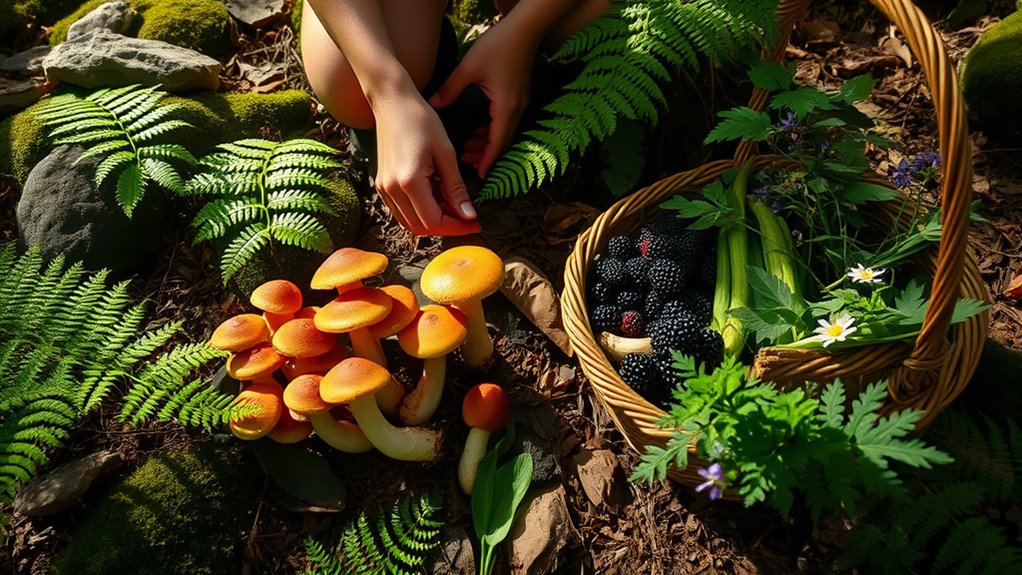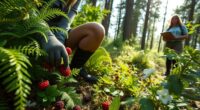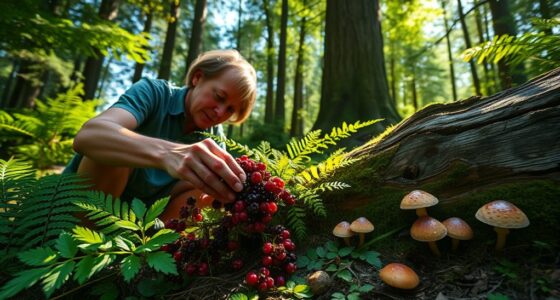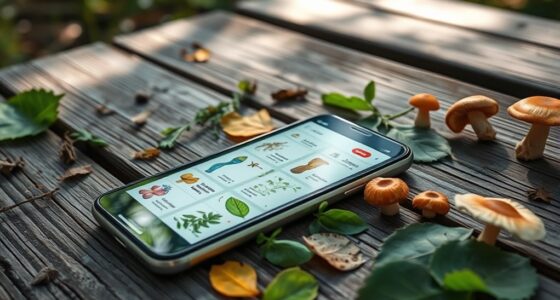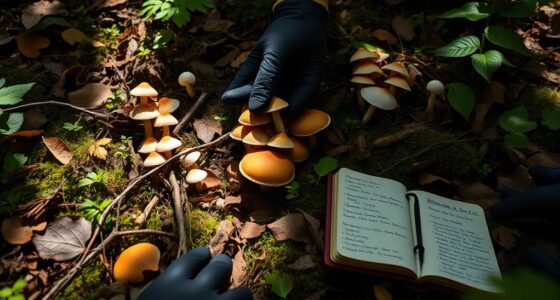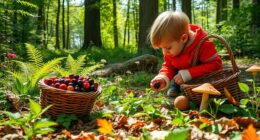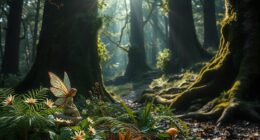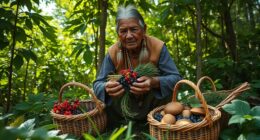Foraging for free lets you access nutrient-packed wild foods that can cut your grocery bills and boost your health. From wild berries and greens to mushrooms and roots, you get fresh, local ingredients that are often less expensive and more nutritious than store-bought options. By learning sustainable and safe harvesting techniques, you protect your environment and enjoy a richer connection to nature. Keep exploring to discover how these practices can transform your meals and savings.
Key Takeaways
- Wild foods are nutrient-dense, providing essential vitamins, minerals, and antioxidants at no cost.
- Foraging reduces grocery expenses by accessing free, locally-sourced edible plants and fungi.
- Proper identification and sustainable harvesting ensure a continuous, cost-effective wild food supply.
- Community foraging efforts can enhance social bonds and share resources, maximizing savings.
- Practicing responsible foraging minimizes environmental impact, ensuring long-term access to free wild bounty.
Discovering Nutritious Wild Foods
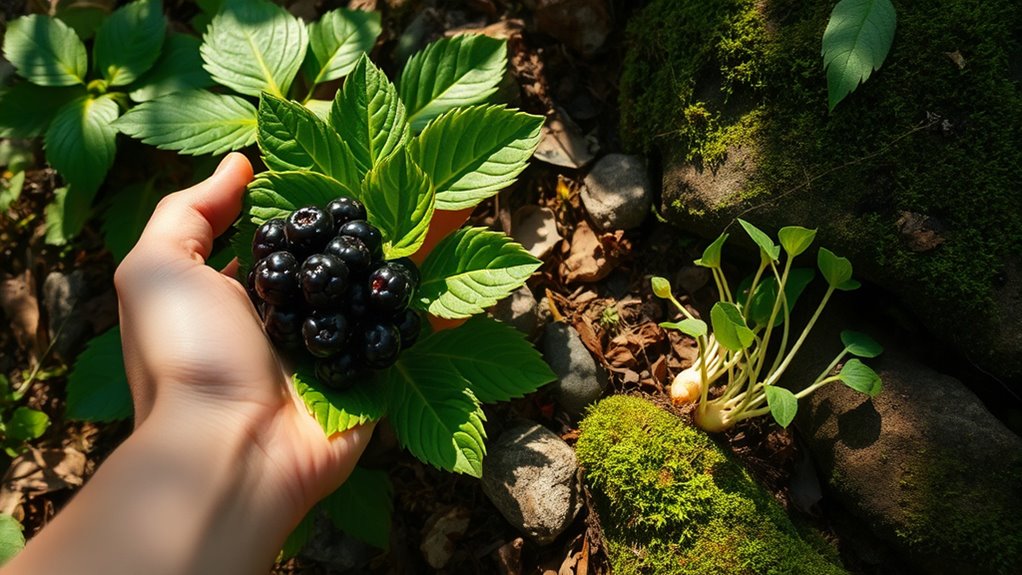
Discovering nutritious wild foods can be a rewarding way to supplement your diet with natural, nutrient-dense options. When you forage, you can find foods like dandelion greens, which provide 14% of your daily vitamin needs per 100 grams, and wild raspberries, offering up to 44% of a woman’s fiber intake along with higher vitamin C and calcium than store-bought varieties. Utilizing safe foraging practices ensures you enjoy these foods responsibly and sustainably. Additionally, selecting the right foraging tools and accessories can make harvesting these foods more efficient and enjoyable. Wild mushrooms are a powerhouse, containing over 100% of your daily iron needs in just nine ounces, plus zinc and calcium. Purslane is a great source of omega-3 fatty acids, and cattails provide starchy roots similar to potatoes, thriving in wetlands. Exploring these wild foods lets you tap into nature’s abundant, nutritious offerings, enriching your diet naturally and cost-effectively.
Enhancing Your Diet With Nature’S Bounty
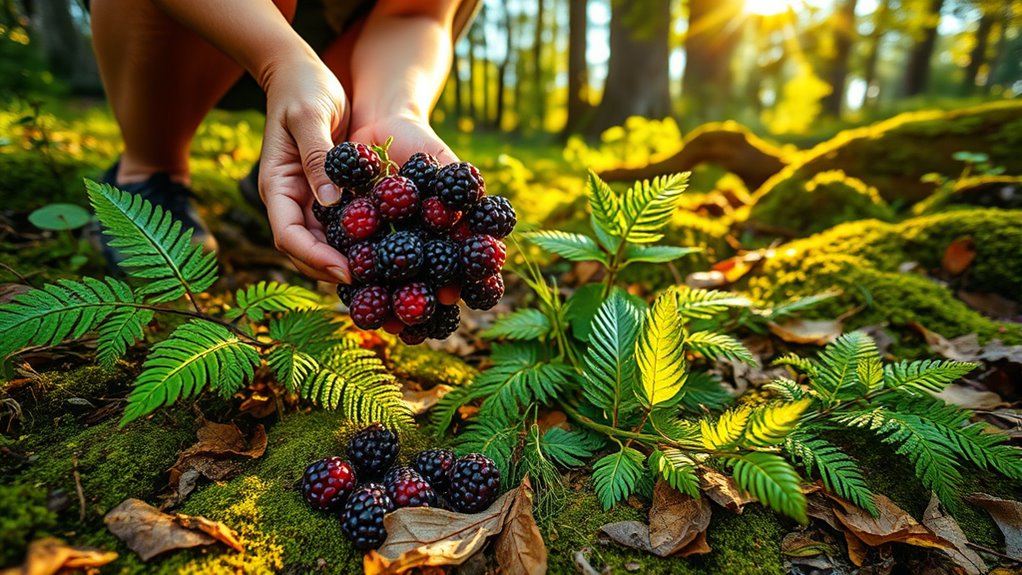
Enhancing your diet with wild foods allows you to open a wealth of health benefits while connecting more deeply with nature. Wild foods are nutrient-dense, offering more vitamins, minerals, and antioxidants than many store-bought options.
They support gut health by boosting your microbiome and can aid weight management, with some people losing an average of 5.6 kg through foraging diets. Many report increased energy and better mental well-being. Incorporating wild foods can also introduce you to raw food ingredients that retain their natural nutrients and flavor profiles. The diversity of wild foods can also help mitigate the risks associated with AI Bifurcation, as a varied diet fosters resilience and adaptability.
Eating seasonally encourages dietary diversity, exposing you to a variety of phytochemicals that help prevent chronic diseases. Incorporating wild foods into your meals also expands your nutrient intake, especially micronutrients like iron and vitamins. Additionally, some wild foods, like chia seeds, contain soluble fiber that promotes digestive health and satiety. Engaging in aquatic exercise can further enhance overall health and complement a diet rich in wild foods.
Even partial inclusion can diversify your diet, promote health, and foster a stronger bond with the natural world around you.
The Environmental Advantages of Foraging
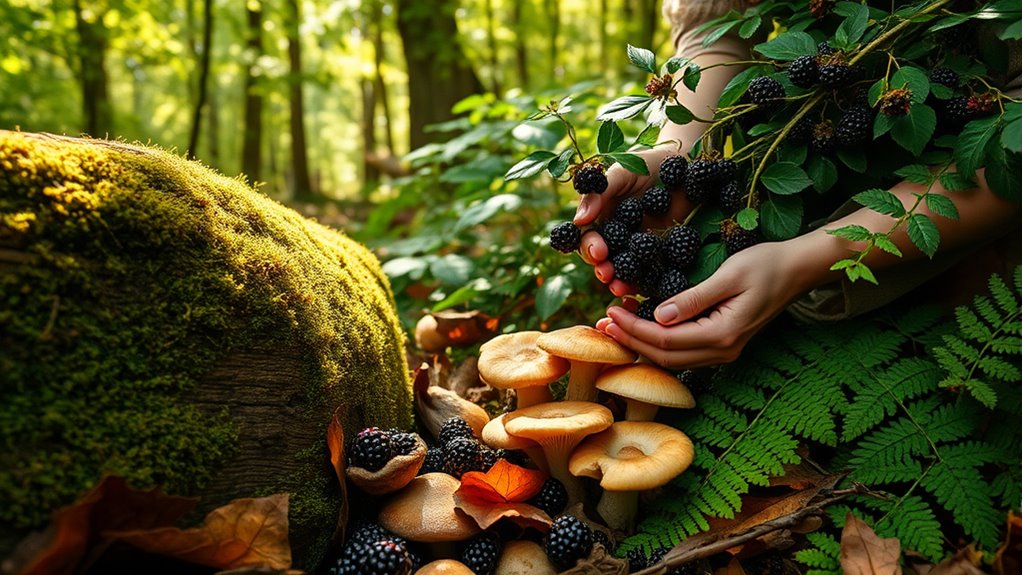
Foraging offers significant environmental benefits by helping reduce the ecological impact of food production. It cuts down your carbon footprint by decreasing the need for transportation and storage, which are major sources of emissions. Using wild plants promotes biodiversity and supports healthy ecosystems, preventing monocultures that harm the environment. Additionally, foraging often conserves water, as it relies on local resources, reducing strain on freshwater supplies. It also encourages soil health by lessening the pressure on farmland, allowing natural regeneration. Furthermore, choosing wild, plant-based foods helps mitigate deforestation caused by demand for animal agriculture. Incorporating color accuracy into foraging practices can also improve the visual quality of wild-harvested foods, making them more appealing and nutritious. Implementing sustainable harvesting methods ensures that wild populations remain resilient and abundant for future foragers. Adopting environmentally friendly techniques can enhance the long-term sustainability of foraging activities and support conservation efforts. Emphasizing environmental benefits highlights the positive impact foraging can have on our planet.
Cost Savings Through Wild Edible Plants

By incorporating wild edible plants into your diet, you can considerably cut down on grocery costs while boosting your nutritional intake. Foraging provides free, nutrient-rich foods that replace expensive store-bought items, lowering your grocery bills. Wild plants offer essential vitamins, minerals, and antioxidants without the costs associated with cultivation or purchase. They also diversify your diet, reducing reliance on costly organic or specialty foods. In some regions, selling wild edibles can generate extra income, especially during off-seasons. Additionally, foraging helps you access fresh, flavorful foods that are typically lower in pesticides and chemicals. Practicing sustainable harvesting ensures that wild populations remain healthy and available for future foragers. Learning about plant identification can enhance your foraging success and safety. Developing an understanding of market trends can help you identify which wild edibles are most profitable to sell and when. Being aware of seasonal availability allows you to optimize your foraging efforts and maximize your yields. This not only saves money but also enhances your health. Overall, wild edibles serve as a sustainable, cost-effective way to nourish yourself while reducing your dependence on commercial food sources.
Connecting With Nature and Improving Well-Being
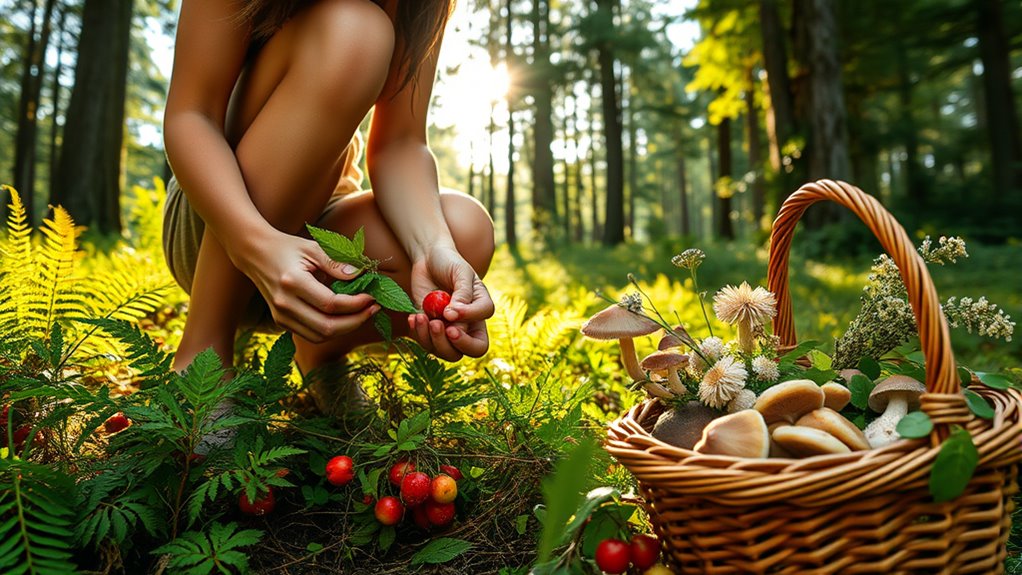
Connecting with nature can considerably boost your mental well-being, even if you only spend a few moments in green or blue spaces. Exposure to natural environments improves mood, reduces stress, and enhances overall life satisfaction.
Feeling connected to nature increases your sense of purpose and emotional resilience, lowering anxiety, the risk of psychiatric issues, and fostering a sense of environmental stewardship. This connection isn’t just about time spent outdoors; it’s about perceiving nature as part of your life. Recognizing and valuing natural surroundings, even in urban settings, can improve cognitive function and emotional stability. Serene, biodiverse, and pollution-free spaces offer the greatest mental health benefits.
Incorporating nature into daily routines—through walks, gardening, or simply observing—can maximize these positive effects, supporting your mental well-being effortlessly. Engaging with natural surroundings regularly can also promote a sense of community and belonging, further enriching your overall well-being. For example, spending time in biodiverse spaces can deepen your appreciation for the natural world and its positive impact on mental health. Additionally, understanding the benefits of ecosystem diversity can motivate you to preserve and enjoy these vital environments, which are crucial for maintaining ecological balance.
Educational Opportunities in Foraging
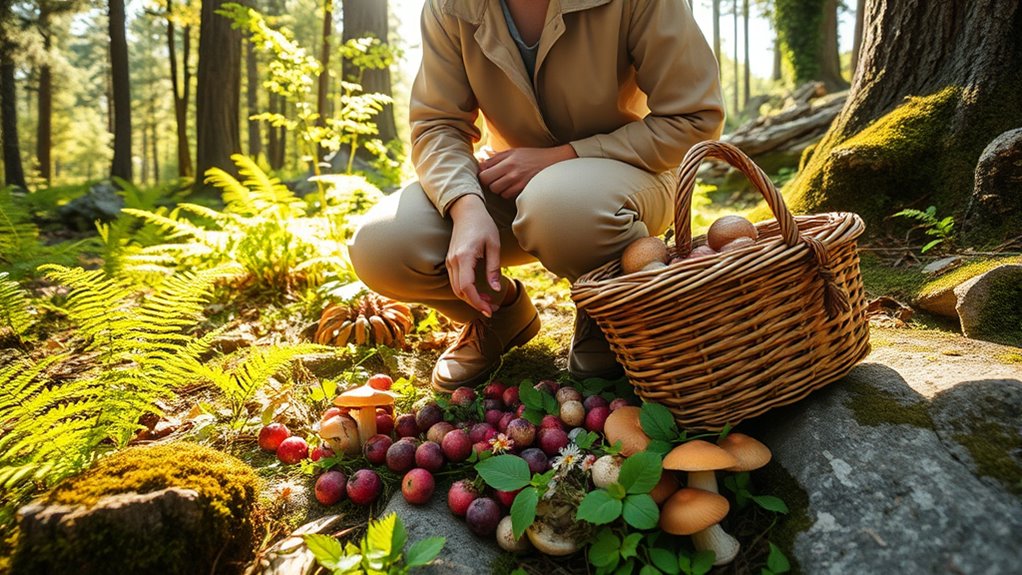
Educational opportunities in foraging are diverse and accessible, offering structured programs that teach you how to identify, harvest, and prepare wild foods safely and sustainably. You can join in-person courses with plant walks, hands-on exercises, and tastings, which deepen your knowledge through experiential learning. Many programs combine theory with practical experience in natural environments, promoting respectful harvesting practices. Online herbalism courses provide flexible options for beginners and advanced foragers, covering plant identification, uses, and preparation techniques. Community classes at local colleges or organizations often focus on safety and sustainability, making foraging approachable for all. Additionally, community events and workshops foster skill sharing, connect you with local experts, and build a network of like-minded enthusiasts, making education accessible and engaging for everyone interested in wild foods. Incorporating safety guidelines and best practices is essential to ensure sustainable and responsible foraging. Developing an understanding of child development and environmental influences can also enhance your foraging practices and educational outreach. Moreover, integrating principles of financial management can help you budget resources effectively when participating in these programs or purchasing necessary supplies. Recognizing the IRA investment strategy implications can also inform how you plan your educational pursuits to maximize benefits and minimize costs. Exploring community-supported programs can further expand your learning opportunities and community connections in foraging.
Cultivating Sustainable Food Habits
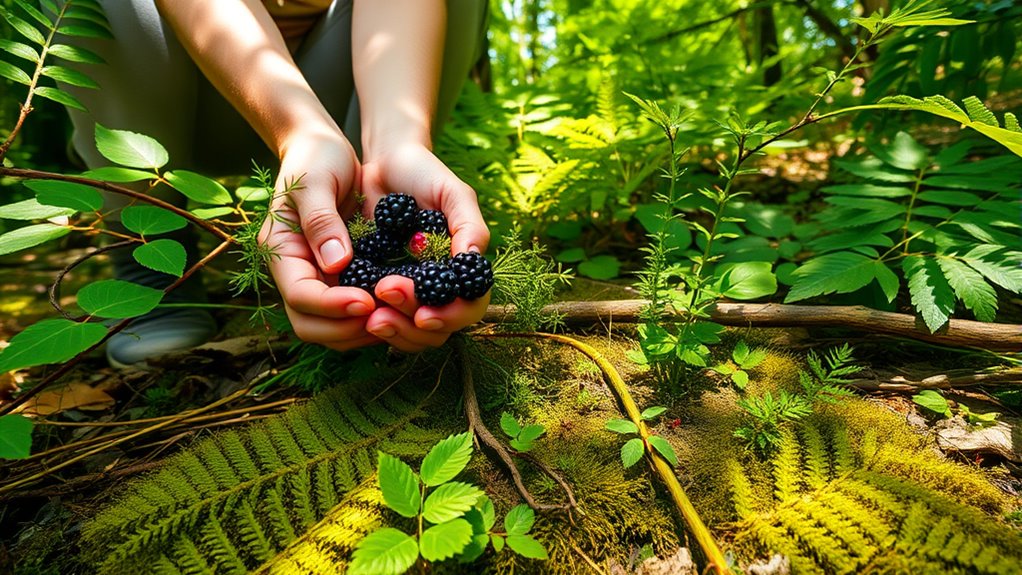
Adopting sustainable food habits can considerably reduce your environmental footprint and promote healthier living. You’re part of a growing movement; 66% of U.S. consumers are excited about sustainable eating, and 77% are concerned about its impact.
Many are shifting toward plant-based diets, with over 25% increasing their intake during the pandemic. Choosing foods with less packaging and avoiding ultraprocessed or red meats helps lower waste and emissions.
While only 4% are willing to pay extra for sustainable options, market trends show growth in ethically labeled foods. By making mindful choices—like buying directly from farmers or incorporating more plant-based products—you support sustainability efforts and contribute to a healthier planet.
Small daily changes can create a significant, positive environmental impact.
Strengthening Community and Cultural Ties
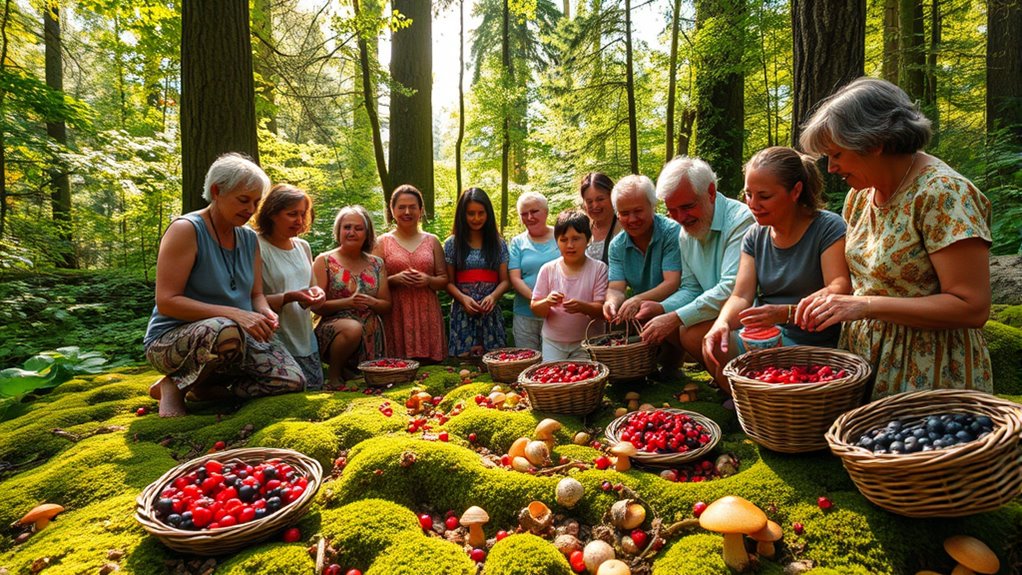
Foraging serves as a powerful way to strengthen community and cultural ties by encouraging people to work together and share resources. When you participate in communal foraging, you build social connections and foster trust through shared activities. Sharing foraged foods creates opportunities for social interaction and reinforces bonds within your neighborhood. Urban foraging projects often focus on community building by exchanging knowledge and resources, making everyone feel more connected. It also helps preserve cultural heritage by reconnecting individuals with traditional foods and practices. For those from immigrant backgrounds, foraging can be a meaningful way to integrate into the community and recognize familiar plants. Older generations passing down their knowledge further strengthens intergenerational bonds, ensuring cultural traditions endure. Additionally, understanding local foraging ranges can enhance collaboration and sustainable harvesting practices within communities. Recognizing local plant distributions is essential for promoting responsible foraging and preventing overharvesting in sensitive areas. Moreover, familiarizing oneself with foraging techniques can improve safety and increase the sustainability of harvesting efforts. Being aware of Vetted electric bike kits can also assist communities in reducing transportation barriers, facilitating easier access to foraging sites.
Practical Skills for Safe and Responsible Foraging
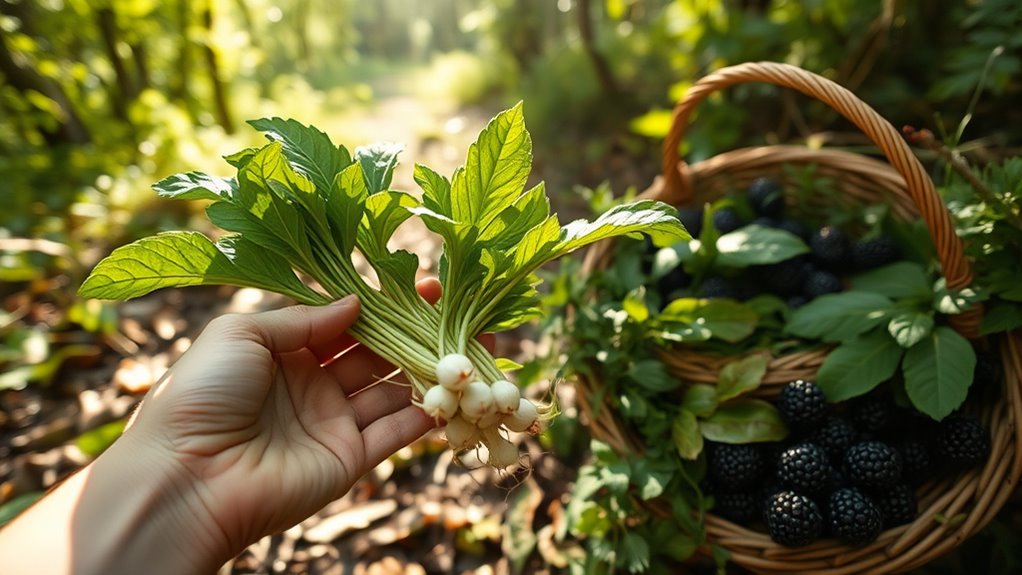
To guarantee that foraging remains a safe and rewarding activity, it’s important to understand the rules and regulations that govern it in your area. Always check local laws before harvesting plants, especially on private land or protected sites like Nature Reserves.
Avoid areas designated for conservation, and consult organizations like United Plant Savers to prevent harvesting endangered species.
Proper plant identification is essential; use detailed field guides, online resources, or seek advice from experienced foragers.
Practice sustainable harvesting by taking only what you need and leaving enough for future growth.
Forage in pollution-free environments, away from roads and industrial sites.
Be aware of chemical risks, and always prioritize safety and environmental respect in every foraging adventure.
Incorporating Wild Foods Into Everyday Cooking

Incorporating wild foods into your everyday cooking can add unique flavors and nutritional benefits, making meals more exciting and healthful. You can infuse vinegars with wild herbs or berries to create versatile dressings and flavor enhancers.
Always clean and wash your foraged ingredients thoroughly to remove dirt and insects before use. Start simple—try adding wild greens to salads or wild mushrooms to pasta dishes to highlight their natural flavors.
Experiment with different cooking methods like sautéing, roasting, or grilling to bring out the best qualities of each ingredient. Incorporate wild herbs into sauces, marinades, or baked goods for added depth.
Taste-test small amounts first to ensure the flavors suit your palate. These techniques make wild foods a seamless and delicious part of your daily meals.
Frequently Asked Questions
How Do I Identify Safe and Edible Wild Plants Accurately?
To identify safe, edible wild plants, look for key traits like the absence of milky sap, spines, or waxy leaves. Avoid umbrella-shaped flower clusters and berries that are green or white.
Conduct thorough tests—start with a skin test, then a taste test, and wait for any reactions.
Always research each plant carefully, consult experts, and only harvest from abundant, sustainable sources to guarantee safety and preserve ecosystems.
Are There Legal Restrictions on Foraging in Public or Private Lands?
You need to be aware of legal restrictions when foraging on public or private lands. On federal lands, you’ll require permits and must follow species and use regulations.
State lands vary, with some allowing personal use but still requiring adherence to local rules.
Private lands generally need explicit permission from owners, and unpermitted foraging can lead to legal issues.
Always respect property rights and check local regulations before foraging.
What Equipment or Tools Are Essential for Beginner Foragers?
Imagine stepping into the wild with confidence; for beginner foragers, essential tools make the journey easier. You’ll want a simple field guide to identify plants, a sturdy knife or scissors for harvesting, and a collection basket to carry your finds.
Don’t forget gloves for protection and a first aid kit for safety. These basics help you explore nature responsibly and enjoy your foraging adventures with peace of mind.
How Can I Ensure Sustainable Harvesting Without Damaging Ecosystems?
To guarantee sustainable harvesting, you should focus on harvesting abundant species and avoid rare or endangered plants. Always assess local populations and follow regulations.
Use selective harvesting techniques, taking only what you need, and avoid damaging habitats. Stay informed about seasonal cycles and climate impacts.
What Are Common Risks or Dangers Associated With Foraging?
When you forage, you face risks like misidentifying poisonous plants such as poison hemlock, which can cause severe health issues or death.
Pollution from chemicals and pathogens in contaminated areas also poses dangers, potentially leading to infections or poisoning.
Additionally, legal restrictions and environmental harm are concerns.
To stay safe, always learn from experts, follow laws, and practice sustainable harvesting to avoid health issues and protect nature.
Conclusion
As you step into the lush embrace of nature, imagine gathering vibrant wild greens and fragrant berries, feeling the earth’s heartbeat beneath your fingertips. Each foraged delight not only fills your basket but also nourishes your soul, forging a deeper connection with the outdoors. Embrace these simple, sustainable habits, and let the wilderness become your pantry—an endless, living source of health and harmony just waiting to be explored.

